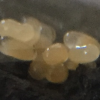Hi all!
I got a bee in my bonnet the other day and started working on this. I figured I'd check and see if this is a good idea before I put more time into it.
The material is soapstone, it's a very soft stone composed mostly of talc. My two concerns with this using this material for a formicarium are moisture, and a heat gradient.
You can see the water reservoir I'm working into the bottom left of the stone. I'll make it deeper and wider, and extend a channel from the reservoir to the tunnel directly to the right, as well as a channel leading to the left, outside of the formicarium, which I will use to refill it. This stone does not absorb water, will this create enough humidity for the nest? Recommendations on what to put inside it? I was considering a piece of an aquarium filter, or sponge.
On to heat. From what I've read about this stone, it takes a while to heat up, but it distributes the heat very evenly and holds it very well. I would like to set this formicarium inside of an outworld. Would a heat lamp above the outworld be sufficient? I have a heat pad, as well as a heat cable, so I have options. I have a feeling that the entire stone will eventually heat to a consistent temperature from top to bottom. I'll definitely test it out and take some measurements before I put any ants into it.
I'm in no hurry to put ants in this, by the way. I currently only have one queen in a test tube with no brood as of yet. Super new in this hobby, but I gather it's better to start working on a formicarium too soon rather than too late. Because I will have ants ![]()
Any input is very much appreciated!
















